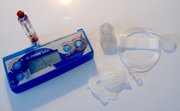Insulin pump
|
|
An insulin pump is a device used for administering insulin in the treatment of diabetes mellitus.
The device consists principally of three parts :
- the pump itself including controls, processing module, and batteries
- delivery tube to carry the insulin
- needle or more commonly a catheter inserted into the body subcutaneously
The insulin pump delivers a single type of fast-acting insulin in two ways :
- a basal (small) dose that is delivered constantly
- a bolus dose that is delivered before meals or to correct high blood glucose levels
Insulin_pump_in_use.jpg
Because a single type of insulin is used, it is easier to determine the effect of a given dose by looking at the delivery profile of that insulin. Insulin pumps also make it possible to deliver much smaller amounts of insulin than can be injected using a syringe. This provides tighter control over blood sugar and Hemoglobin A1c levels, reducing the chance of long-term complications associated with diabetes.
The amount of insulin delivered for a bolus is determined by the bloodsugar level and the grams of carbohydrates consumed. In all cases, delivery rates are determined by the user in consultation with his endocrinologist. Currently there is no means to automatically control the insulin delivery based on the blood glucose level of the user.
Use of insulin pumps is increasing as it provides an easier means to deliver multiple insulin injections for those using intensive insulinotherapy.

